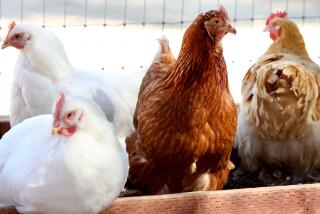Tornadoes went after Alabama’s chickens
Dorman Grace stood among the ruins of his chicken farm — the buildings were a tangle of sheet metal, plastic insulation and chicken corpses. Each day has been a game of hide-and-seek with thousands of surviving chicks wandering around the disaster zone.
The tornadoes that barreled through Alabama last week took a mean swipe at the state’s abundant poultry farms, wiping out about 200 chicken houses and damaging 500 others. Nearly 2.5 million chickens were killed statewide, and about the same number were left without shelter. One grower was forced to euthanize nearly 200,000 chicks, unable to properly house them.
Although the losses are not expected to affect national chicken supplies or prices, hard-hit Alabama farmers believe they will suffer deeply in a state that ranks as the third-largest chicken producer in the country.
Grace, a third-generation chicken famer, said he expects to lose about $250,000 this year and that it will cost $1 million more to rebuild.
Yet he knows he was lucky. His country home is still standing. His wife, his sons and his dogs are safe. So are his cows.
“What I really don’t know is where I’m going to put all this junk,” he said, staring at the debris. “In the towns, they’ll come out and clean up, but here, we’re on our own.”
Out on Grace’s 214-acre farm, the 55-year-old spent another day this week trying to pick up the mess — and capture chickens — with the help of his 20-year-old son, Jud, and a few of his friends.
Patiently, they waited until nightfall when the birds huddled for bedtime. Then they snuck up on the chicks and swooped them up by the handful.
In the days after the storm, he has rounded up nearly 50,000 chickens and had about 200 left to gather Wednesday. Those that had been caught were trucked away to new sheds by Pilgrim’s, the chicken producer with whom Grace contracts.
Grace never imagined he’d see days like these. His great-great-great-grandfather came to Alabama in 1859. The family eventually settled in Jasper, a land of open hillsides 35 miles northwest of Birmingham.
“My dad chopped down trees and built his own house when he returned from World War II,” Grace said, pointing to a little house on the southwest end of the farm.
They began poultry farming in 1952, along with other Alabamians. The more the country migrated to cities, the more life changed for the Graces. They became part of an elaborate industry of feed mills, hatchers, growers and processing plants, all working for a company to deliver chickens to grocery stores and restaurants such as McDonald’s and Popeye’s Chicken.
Grace’s job is to take day-old chicks, fatten them up with corn and soy meal, then in six to eight weeks send them to Pilgrim’s to be readied for the dinner table.
As his wife, Susan, prepared lunch in a kitchen decorated with roosters, Grace walked over to an iron safe and retrieved a weathered binder full of old newspaper clippings.
“This one here is from 1964,” he said, pointing to an article featuring him at age 8, his two brothers and his parents on the cover. “We were chosen as Farm Family of the Year.”
“And this one here,” he said, proudly, “you’ll probably recognize.”
It was a clipping from 1974. Grace was 18, his hair covered his ears like Paul McCartney and he wore a green suit. In the photo, he is shaking hands with a bespectacled white-haired man in a white suit, someone any poultry farmer in the country would be tickled to meet.
“It’s Colonel Sanders,” he said. “Founder of Kentucky Fried Chicken.”
esmeralda.bermudez@latimes.com
More to Read
Sign up for Essential California
The most important California stories and recommendations in your inbox every morning.
You may occasionally receive promotional content from the Los Angeles Times.











